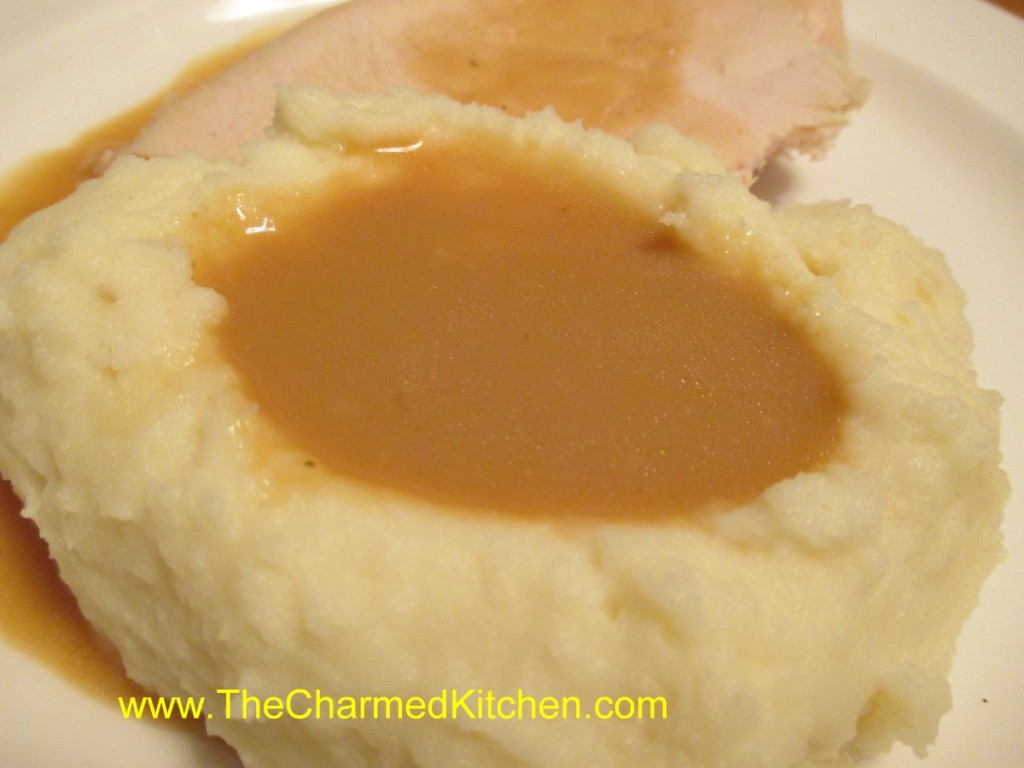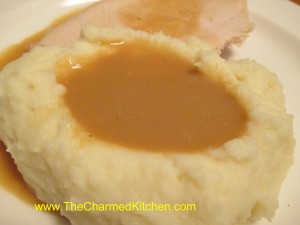Gravy 101

I had a conversation with a friend recently about making gravy. She said she often buys canned gravy because hers doesn’t always work out. I found that kind of sad. Gravy is so easy to make. I thought with so many people planning turkey dinners it might be a good time to post some tips for making really good gravy- every time. I’ve also included some ideas for gluten free gravy and ways to de-fat your gravy, too. For those of you who have trouble making gravy I hope this helps.
Gravy 101
1. Make a stock using wing tips and the neck and giblets, other than the liver. Use onions, carrots and some celery to add flavor and you might even use a paste-type soup base (chicken or turkey) in place of the salt and to add flavor. Just place everything in a saucepan and cover with cold water. Simmer a couple of hours and strain. I also add some herbs like parsley, thyme and a little marjoram. Don’t make too salty. I use an organic reduced sodium soup base.
2. De-glaze the roasting pan after removing the turkey. Just place the pan on a burner and add the strained stock. Turn on the burner and stir around the stock to loosen and brown bits in the bottom of the pan. This is where the gravy really gets its flavor. Strain this mixture back into the saucepan you were using to make the stock.
3. Thicken with flour and water or flour and milk, depending on your taste. I like using milk. Place flour in a jar with a tight fitting lid and cover with cold milk or water. Screw on lid and shake until mixture is smooth. You’ll need about 2 tablespoons of flour for each cup of liquid, depending on how thick or thin you like your gravy.
4. Add to the strained mixture in the saucepan and cook, stirring until thickened. Adjust seasonings and serve. If it’s too thin for your taste, just add more flour and milk or water. It is easier to add a little more flour if the gravy is too thin than to thin gravy that is too thick. Make at least ¼ cup per person plus extra for leftovers the next day.
Note: You can also thicken the gravy while it is still in the roasting pan and then strain it into a saucepan.
Gluten Free Gravy
If you want gluten free gravy you have the option of thickening it with cornstarch. I know a lot of people that swear by cornstarch. My only problem with cornstarch is that it will break and get watery when you want to reheat the gravy. I have made gluten free gravy by just saving the veggies I used to make the stock with the giblets. Usually it’s a mixture of carrots, onions and celery. After simmering in the stock they are very soft. I place the veggies in with the drippings and the stock in the roasting pan and stir it all around. I place in a saucepan and use an immersion blender to smooth it all up. The veggies thicken the gravy with no added flour.
De-fatting Gravy
There will be fat in the gravy. I remember my Mother’s gravy boat with a spout that came from the bottom- so you poured the gravy out from the bottom- leaving the fat behind. You can get rid of most of the fat quickly a couple of different ways. You can get a de-fatting cup. It looks like a measuring cup with a spout that comes up from the bottom. Ladle the gravy into the cup and pour it out into a saucepan or gravy boat. You can also take your freshly made gravy and let it sit for a few minutes in the pot, off the heat. Use a metal spoon to skim off the fat then grab a handful of ice cubes and place them on the top of the gravy. The ice will freeze the fat. Move them around the surface very gently. The fat will harden on the ice cubes. Use a slotted spoon to remove the ice cubes with most of the fat stuck to them. Do this quickly, so you don’t dilute your gravy.
Gravy 101
I had a conversation with a friend recently about making gravy. She said she often buys canned gravy because hers doesn’t always work out. I found that kind of sad. Gravy is so easy to make. I thought with so many people planning turkey dinners it might be a good time to post some tips for making really good gravy- every time. I’ve also included some ideas for gluten free gravy and ways to de-fat your gravy, too. For those of you who have trouble making gravy I hope this helps.
Gravy 101
1. Make a stock using wing tips and the neck and giblets, other than the liver. Use onions, carrots and some celery to add flavor and you might even use a paste-type soup base (chicken or turkey) in place of the salt and to add flavor. Just place everything in a saucepan and cover with cold water. Simmer a couple of hours and strain. I also add some herbs like parsley, thyme and a little marjoram. Don’t make too salty. I use an organic reduced sodium soup base.
2. De-glaze the roasting pan after removing the turkey. Just place the pan on a burner and add the strained stock. Turn on the burner and stir around the stock to loosen and brown bits in the bottom of the pan. This is where the gravy really gets its flavor. Strain this mixture back into the saucepan you were using to make the stock.
3. Thicken with flour and water or flour and milk, depending on your taste. I like using milk. Place flour in a jar with a tight fitting lid and cover with cold milk or water. Screw on lid and shake until mixture is smooth. You’ll need about 2 tablespoons of flour for each cup of liquid, depending on how thick or thin you like your gravy.
4. Add to the strained mixture in the saucepan and cook, stirring until thickened. Adjust seasonings and serve. If it’s too thin for your taste, just add more flour and milk or water. It is easier to add a little more flour if the gravy is too thin than to thin gravy that is too thick. Make at least ¼ cup per person plus extra for leftovers the next day.
Note: You can also thicken the gravy while it is still in the roasting pan and then strain it into a saucepan.
Gluten Free Gravy
If you want gluten free gravy you have the option of thickening it with cornstarch. I know a lot of people that swear by cornstarch. My only problem with cornstarch is that it will break and get watery when you want to reheat the gravy. I have made gluten free gravy by just saving the veggies I used to make the stock with the giblets. Usually it’s a mixture of carrots, onions and celery. After simmering in the stock they are very soft. I place the veggies in with the drippings and the stock in the roasting pan and stir it all around. I place in a saucepan and use an immersion blender to smooth it all up. The veggies thicken the gravy with no added flour.
De-fatting Gravy
There will be fat in the gravy. I remember my Mother’s gravy boat with a spout that came from the bottom- so you poured the gravy out from the bottom- leaving the fat behind. You can get rid of most of the fat quickly a couple of different ways. You can get a de-fatting cup. It looks like a measuring cup with a spout that comes up from the bottom. Ladle the gravy into the cup and pour it out into a saucepan or gravy boat. You can also take your freshly made gravy and let it sit for a few minutes in the pot, off the heat. Use a metal spoon to skim off the fat then grab a handful of ice cubes and place them on the top of the gravy. The ice will freeze the fat. Move them around the surface very gently. The fat will harden on the ice cubes. Use a slotted spoon to remove the ice cubes with most of the fat stuck to them. Do this quickly, so you don’t dilute your gravy.




